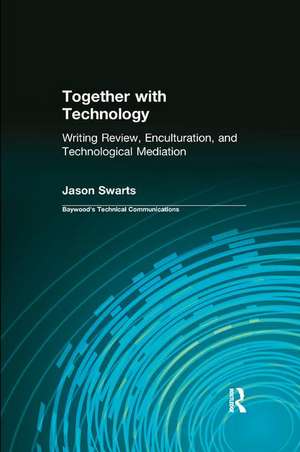Together with Technology: Writing Review, Enculturation, and Technological Mediation: Baywood's Technical Communications
Autor Jason Swartsen Limba Engleză Paperback – 7 feb 2017
| Toate formatele și edițiile | Preț | Express |
|---|---|---|
| Paperback (1) | 450.02 lei 6-8 săpt. | |
| Taylor & Francis – 7 feb 2017 | 450.02 lei 6-8 săpt. | |
| Hardback (1) | 1218.26 lei 6-8 săpt. | |
| Taylor & Francis – 15 dec 2007 | 1218.26 lei 6-8 săpt. |
Din seria Baywood's Technical Communications
- 5%
 Preț: 330.57 lei
Preț: 330.57 lei - 5%
 Preț: 496.09 lei
Preț: 496.09 lei - 5%
 Preț: 455.08 lei
Preț: 455.08 lei - 26%
 Preț: 414.24 lei
Preț: 414.24 lei - 5%
 Preț: 451.31 lei
Preț: 451.31 lei - 14%
 Preț: 318.90 lei
Preț: 318.90 lei - 17%
 Preț: 331.25 lei
Preț: 331.25 lei - 12%
 Preț: 333.67 lei
Preț: 333.67 lei - 18%
 Preț: 1056.80 lei
Preț: 1056.80 lei - 15%
 Preț: 639.47 lei
Preț: 639.47 lei - 25%
 Preț: 415.11 lei
Preț: 415.11 lei - 5%
 Preț: 392.32 lei
Preț: 392.32 lei - 25%
 Preț: 540.68 lei
Preț: 540.68 lei - 26%
 Preț: 442.64 lei
Preț: 442.64 lei - 5%
 Preț: 453.13 lei
Preț: 453.13 lei - 5%
 Preț: 496.09 lei
Preț: 496.09 lei - 5%
 Preț: 338.37 lei
Preț: 338.37 lei - 5%
 Preț: 453.33 lei
Preț: 453.33 lei - 26%
 Preț: 820.32 lei
Preț: 820.32 lei - 5%
 Preț: 458.23 lei
Preț: 458.23 lei -
 Preț: 422.59 lei
Preț: 422.59 lei - 28%
 Preț: 819.90 lei
Preț: 819.90 lei - 21%
 Preț: 639.77 lei
Preț: 639.77 lei -
 Preț: 479.09 lei
Preț: 479.09 lei - 18%
 Preț: 721.16 lei
Preț: 721.16 lei -
 Preț: 356.18 lei
Preț: 356.18 lei -
 Preț: 489.00 lei
Preț: 489.00 lei - 26%
 Preț: 489.55 lei
Preț: 489.55 lei - 17%
 Preț: 298.99 lei
Preț: 298.99 lei - 15%
 Preț: 638.95 lei
Preț: 638.95 lei - 59%
 Preț: 421.16 lei
Preț: 421.16 lei - 51%
 Preț: 365.39 lei
Preț: 365.39 lei
Preț: 450.02 lei
Preț vechi: 473.71 lei
-5% Nou
Puncte Express: 675
Preț estimativ în valută:
86.12€ • 93.52$ • 72.34£
86.12€ • 93.52$ • 72.34£
Carte tipărită la comandă
Livrare economică 22 aprilie-06 mai
Preluare comenzi: 021 569.72.76
Specificații
ISBN-13: 9780415783736
ISBN-10: 0415783739
Pagini: 180
Dimensiuni: 152 x 229 x 10 mm
Greutate: 0.25 kg
Ediția:1
Editura: Taylor & Francis
Colecția Routledge
Seria Baywood's Technical Communications
Locul publicării:Oxford, United Kingdom
ISBN-10: 0415783739
Pagini: 180
Dimensiuni: 152 x 229 x 10 mm
Greutate: 0.25 kg
Ediția:1
Editura: Taylor & Francis
Colecția Routledge
Seria Baywood's Technical Communications
Locul publicării:Oxford, United Kingdom
Public țintă
Professional Practice & DevelopmentCuprins
Introduction
Chapter 1: Texts and Knowledge Work
Discusses texts and their importance to organizations. Texts make knowledge tangible, promote learning, support adaptation, encourage coordination, and support cognitive tasks.
Chapter 2: Writing Review and Mediation
Discusses the dual purpose for writing review: to produce better texts and better writers. Considers how this work is offloaded to people and technologies.
Chapter 3: Affordances of Texts and Textual Technologies
Discusses the socio-cognitive affordances of texts in paper and electronic form. Questions the suitability of paper text for writing review, instead promoting textual replay.
Chapter 4: Study Design and Data Analysis
Discusses the design of a study to test whether paper or textual replay helps writers produce better writing and better organization-specific writing practices.
Chapter 5: Differences between Text and Textual Replay Mediation
Discusses the differences between text and textual replay mediation use in five organizations. Textual replay helps writers and reviewers focus on writing process.
Chapter 6: Textual Replay in Practice-Oriented Organizations
Discusses use of textual replay in organizations that employ professional writers. Textual replay helps promote cooperative writing and discussion of process.
Chapter 7: Textual Replay in Artifact-Oriented Organizations
Discusses use of textual replay in organizations that employ "non-writers". Textual replay promotes contextualization of texts as organizationally-significant artifacts. Process is coordinated with organizational demands.
Chapter 8: Designing Technology to Support Practice
Summarizes findings from the study and explores ways to use these findings to further the design of writing review technologies. The author offers some suggestions.
Chapter 1: Texts and Knowledge Work
Discusses texts and their importance to organizations. Texts make knowledge tangible, promote learning, support adaptation, encourage coordination, and support cognitive tasks.
Chapter 2: Writing Review and Mediation
Discusses the dual purpose for writing review: to produce better texts and better writers. Considers how this work is offloaded to people and technologies.
Chapter 3: Affordances of Texts and Textual Technologies
Discusses the socio-cognitive affordances of texts in paper and electronic form. Questions the suitability of paper text for writing review, instead promoting textual replay.
Chapter 4: Study Design and Data Analysis
Discusses the design of a study to test whether paper or textual replay helps writers produce better writing and better organization-specific writing practices.
Chapter 5: Differences between Text and Textual Replay Mediation
Discusses the differences between text and textual replay mediation use in five organizations. Textual replay helps writers and reviewers focus on writing process.
Chapter 6: Textual Replay in Practice-Oriented Organizations
Discusses use of textual replay in organizations that employ professional writers. Textual replay helps promote cooperative writing and discussion of process.
Chapter 7: Textual Replay in Artifact-Oriented Organizations
Discusses use of textual replay in organizations that employ "non-writers". Textual replay promotes contextualization of texts as organizationally-significant artifacts. Process is coordinated with organizational demands.
Chapter 8: Designing Technology to Support Practice
Summarizes findings from the study and explores ways to use these findings to further the design of writing review technologies. The author offers some suggestions.
Descriere
Examines the roles that texts serve as parts of an organizational cognitive infrastructure. This book reports on a study of the impact of two technologies (paper text and textual replay) on writing review.
